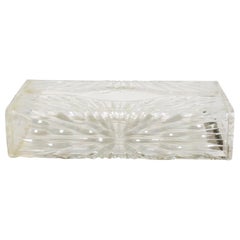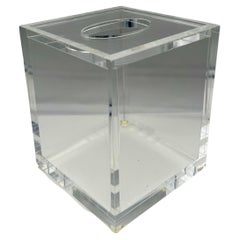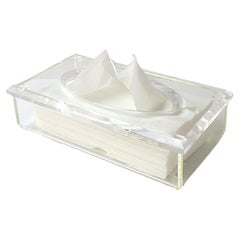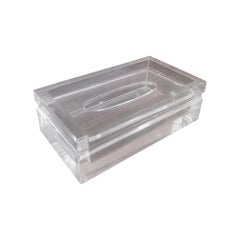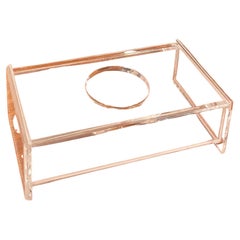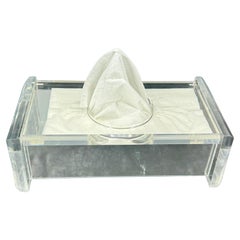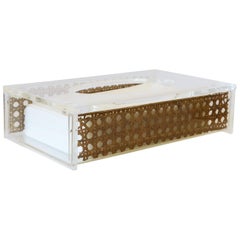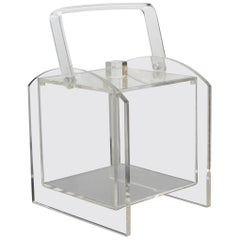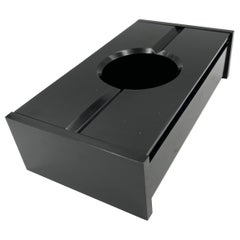Lucite Tissue Box
Mid-20th Century American Hollywood Regency Bathroom Fixtures
Metal
Late 20th Century Modern Bathroom Fixtures
Lucite
Mid-20th Century North American Post-Modern More Desk Accessories
Lucite
Late 20th Century Modern Bathroom Fixtures
Lucite, Acrylic
Late 20th Century Modern Bathroom Fixtures
Lucite
Late 20th Century Modern Bathroom Fixtures
Lucite
Mid-20th Century North American Mid-Century Modern More Desk Accessories
Lucite
Mid-20th Century North American Mid-Century Modern More Desk Accessories
Lucite
Mid-20th Century American Mid-Century Modern Bathroom Fixtures
Mirror, Lucite
Late 20th Century Modern Bathroom Fixtures
Cane, Acrylic, Wicker
Recent Sales
Vintage 1970s Mid-Century Modern Decorative Boxes
Lucite
20th Century Italian Post-Modern Decorative Boxes
Lucite
Vintage 1960s Hollywood Regency Bathroom Fixtures
Acrylic
Vintage 1980s American Modern Bathroom Fixtures
Lucite
Vintage 1970s American Modern More Furniture and Collectibles
Lucite
Late 20th Century American Modern Decorative Boxes
Acrylic, Lucite
People Also Browsed
Vintage 1970s Swiss Mid-Century Modern Sofas
Leather
21st Century and Contemporary Vietnamese Regency End Tables
Wood
Antique 1820s English Regency Vases
Porcelain
21st Century and Contemporary Mexican Mid-Century Modern Floor Lamps
Textile, Wood, Linen, Fiberglass
2010s Belgian Modern Club Chairs
Linen
2010s Italian Art Deco Screens and Room Dividers
Brass
2010s American Other Benches
Fabric, Rope, Lambskin, Mohair, Acrylic, Lucite
20th Century English Planters and Jardinieres
Majolica
Vintage 1980s Italian Mid-Century Modern Lounge Chairs
Chrome
Antique Mid-19th Century English High Victorian Taxidermy
Other
21st Century and Contemporary European Modern Wall Mirrors
Brass
Vintage 1950s Italian Mid-Century Modern Sofas
Metal
Vintage 1970s Italian Mid-Century Modern Vanities
Fabric, Plastic
Vintage 1970s American Modern Sofas
Chrome
Vintage 1960s Italian Mid-Century Modern Vanities
Faux Leather
21st Century and Contemporary American Minimalist Benches
Lucite
Lucite Tissue Box For Sale on 1stDibs
How Much is a Lucite Tissue Box?
Materials: Plastic Furniture
Arguably the world’s most ubiquitous man-made material, plastic has impacted nearly every industry. In contemporary spaces, new and vintage plastic furniture is quite popular and its use pairs well with a range of design styles.
From the Italian lighting artisans at Fontana Arte to venturesome Scandinavian modernists such as Verner Panton, who created groundbreaking interiors as much as he did seating — see his revolutionary Panton chair — to contemporary multidisciplinary artists like Faye Toogood, furniture designers have been pushing the boundaries of plastic forever.
When The Graduate's Mr. McGuire proclaimed, “There’s a great future in plastics,” it was more than a laugh line. The iconic quote is an allusion both to society’s reliance on and its love affair with plastic. Before the material became an integral part of our lives — used in everything from clothing to storage to beauty and beyond — people relied on earthly elements for manufacturing, a process as time-consuming as it was costly.
Soon after American inventor John Wesley Hyatt created celluloid, which could mimic luxury products like tortoiseshell and ivory, production hit fever pitch, and the floodgates opened for others to explore plastic’s full potential. The material altered the history of design — mid-century modern legends Charles and Ray Eames, Joe Colombo and Eero Saarinen regularly experimented with plastics in the development of tables and chairs, and today plastic furnishings and decorative objects are seen as often indoors as they are outside.
Find vintage plastic lounge chairs, outdoor furniture, lighting and more on 1stDibs.
